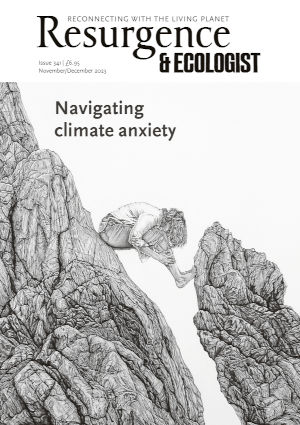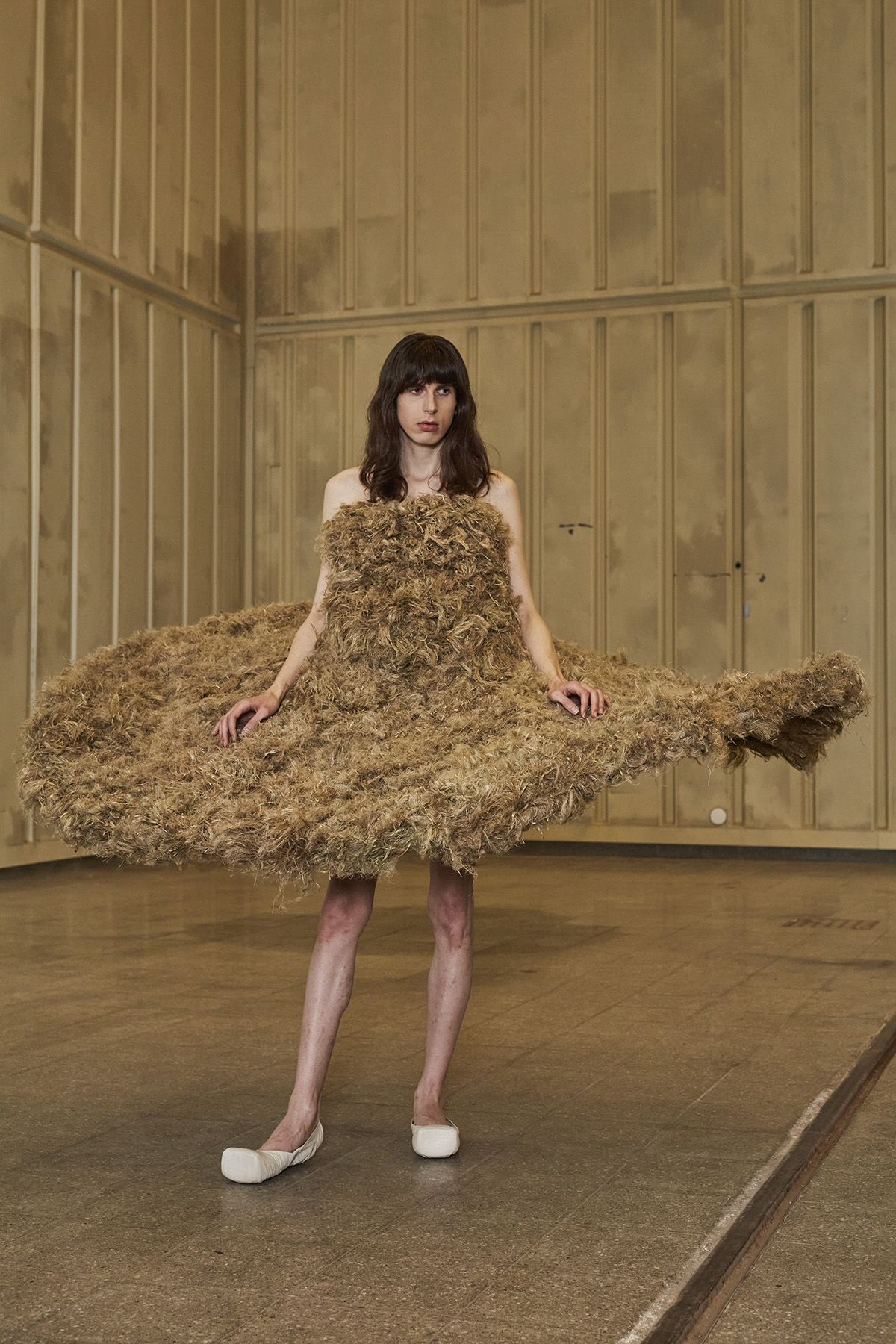The introduction to Ruusa Vuori’s work contains this: “Borders and crossings are essential: different surfaces, membranes, openings, holes, as well as pushing through them,” and this: “Clothing can … draw boundaries or break them.” The Aalto University BA student won the coveted Näytös23 Award at this year’s graduate show at the Suurjännitehalli in Espoo, Finland.
Vuori was among the students I met during this year’s four-day ‘Fashion in Helsinki’ event. She told me the linen threads she had used in her stand-out dress had been planted and grown in her great-grandmother’s garden. “The hypnotic rhythm of the handwork and bodily movements while weaving, knitting, cutting and sewing have deepened my relationship with both inherited and newly acquired materials,” she said.
The fashion industry needs innovation. But the commercial drive for mass production produces the opposite. The prospect of real innovation and sustainable and ethical clothing offered by this event was therefore an intriguing one.
Innovation, in both natural and social contexts, often takes place at the periphery. It is inherently creative and liberating. It can be profoundly challenging. People living on the edge, at intersections, are excluded from the centre where resources are most plentiful, and are forced to innovate simply to survive. Such innovation takes in contradiction: it’s where one and its other meet, bleed and blend.
I arrived in Helsinki with my own preoccupations. But I didn’t need to worry about imposing this on the students, fashion designers and buyers I met during this tour of the fashion industry. Instead, I was welcomed into a community of creatives who had dedicated their lives to exploring many of the same ideas. We had all been thinking about how two opposing concepts can be woven together to make something new.
Finland has a fascinating history. It is the northernmost land bridge between Europe and Asia. It has been Swedish, Russian and, from 1917, an independent state. Lenin planned the revolution from these borderlands; the right later sided with the Nazis who slashed and burned its towns in retreat. Stalin was just as harsh to the Finns.
Politics here continues to flicker between left and right, to lesser extremes. Sanna Marin of the centre-left Social Democratic Party of Finland was voted out as prime minister this year and replaced by Petteri Orpo and his right-wing coalition. When Russia invaded Ukraine, Finland joined NATO.
Juha Vehmaanperä won the Fiskars Award at Näytös21 in Finland and was a finalist for the Grand Prix of the jury Première Vision at the Hyères International Festival of Fashion in 2022. I was lucky enough to meet them this year after they gave a presentation at the Transformation Conference organised by the magazine Scandinavian MIND and Juni Communication at the National Museum of Finland.
Vehmaanperä, aka ‘Craftiest Bitch in Town’, impressed the judges by incorporating both traditional knitting and 3D printing in their designs. The core principle of their work is that people should again make their own clothes, using traditional methods and advances in technology in the production process. “I would like to see a maker culture … rather than a consumer culture,” Vehmaanperä told me.
The boundaries between art, design and fashion are being challenged across Helsinki’s creative industries. We were taken to the exhibition of Kustaa Saksi’s work at the Design Museum. Saksi, from Kouvola, Finland, and currently based in Amsterdam, is a multidisciplinary visual artist “specialising in graphic storytelling through patterns, textile art and installation”.
What we see are massive rugs woven by what must be colossal looms. These carpets include contemporary designs – evocative of Nature’s unboundedness, but also of computer gaming and even psychedelic drug hallucinations. One of Saksi’s collections is called ‘In the Borderlands’. “Saksi takes us on a journey through transitional, eerie spaces that emerge between the imagined and the real, sleep and wakefulness,” states the description on the museum’s website.
The American linguist and philosopher George Lakoff explained in Moral Politics: How Liberals and Conservatives Think that the generation born immediately after the second world war was brought up to respect discipline, rules, and clearly defined and strictly policed boundaries. Conversely, supportive parenting allows for the exploration, negotiation and transgression of boundaries, roles and identities. Authoritarian parenting maps onto a desire for authoritarian government, and vice versa.
Saksi’s generation renegotiates the rules, and he has clearly influenced younger designers. But, for the younger fashion and textile designers, Generation 2023, here in Helsinki, there are no such rules. The provision of free education, of safe cityscapes and public mass transit – scooters, trams and trains – has created an ecosystem where real innovation is blooming. This is the conversation taking place in Helsinki.
Fashion students in Finland bring together the old – including the traditions of weaving, tailoring and mending of their forebears – with the new: techniques and materials only now becoming available. They use material that has been grown, is raw, has become off-cuts, is recycled and will be upcycled. They raid gardens, skips, thrift shops and food bins.
This is the defining feature of the artists and fashion students whose work is collated at the Amos Rex Museum for the Generation 2023 exhibition. Among those chosen were Auri Lukkarinen and Iris Kareoja. I was lucky enough to see their work ‘Knitting Diaries :-)’ on display at the museum and to speak to the artists.
Their art consisted of long woollen ‘print-out’ tapestries knitted on a huge Epson machine provided by KNITWEAR LAB. Each piece stretches across about 20 metres. Kareoja had been recording her spending on a spreadsheet. This ‘data’ was then represented in the different coloured wools used in the knit and hung in this highly stylish contemporary gallery. Lukkarinen took photographs of her morning porridge, and her Instagram-style stream is also captured in wool in what looks like a ginormous scarf.
The work blurs the boundaries between art and fashion, between the mundane and the sublime, between the personal and the public, between the ephemeral and that meant for posterity, between the past and the future, between raw materials and waste materials, between the valued and the unwanted. Indeed, so many binaries were broken that everything seemed in play, in flux. “The borders are dissolved. It’s nice. It’s very exciting,” says one of the artists.
Necessity, the cliché goes, is the mother of invention. Lukkarinen and Kareoja both studied on their BA and MA courses for free. But they had to provide their own materials, which would have been very expensive, so they used leftover merino wool from their BA studies in their MA pieces.
“If we need materials for our work, we go to thrift stores and second-hand shops. We can find all the yarns and fabrics and all the little things we need,” says one. The other adds: “It’s almost a given that you have to take sustainability into consideration. I was exploring how you could use old polyester textiles that you can find in flea markets, elevate them and give them a new lifecycle, bringing value to these materials that are not considered valuable.”
But are all rules to be broken? Are there times when to mix and match, and to blend and break does in fact cause problems from anxiety to pollution? Do we really want a fashion industry that is intent on making its own rules or to have no rules at all? In other words, should our enthusiasm for the unbounded itself be unbounded?
Outi Luukko from Rester, which recycles waste textiles into new fabrics, told me that her team sometimes has to separate cotton from polyester by hand. Some mass production labels sell products as pure cotton even though they are a mix, meaning they cannot be recycled. Shahriare Mahmood, the chief sustainability officer at Spinnova, has a similar problem. His company weaves softer-thancotton materials from biomass – or wood. But the product can only be recycled if it remains ‘pure’. The upcoming EU labelling and supply chain regulations should greatly assist this process.
So which rules are hard and fast, and which are negotiable or even detrimental? Who gets to set the rules? How do we impose the rule that fashion has to be sustainable? There is no simple metarule, no set boundary, about which rules we respect and which we jettison.
Instead, we have the arduous task of gathering evidence, balancing needs, understanding consequences, securing ‘buy in’ and establishing conventions. We need legitimate authorities, consensus and consent. This cannot be delivered through autocracy. Instead, we have to make it the fashion.
It was with a deep sense of sadness that I left Finland. I had a night on a ferry ahead of me followed by three days of trains before I arrived home. It proved to be a remarkably easy journey, as the borders between Sweden, Denmark, Germany, Belgium and France were wide open, frictionless. That is, until I hit Britain. I fear that Helsinki has recently made the same mistake as London, by electing Orpo and his motley government of the centre and hard right.
The well-kept secret of innovation is that it requires substantial investment, genuine autonomy, a spirit of inclusivity and creative leadership. Orpo offers only closed minds and closed borders. Perhaps he should remember King Cnut’s famous warning. Nobody can stop the tide of creativity and kindness demonstrated by Finland’s younger generation.
Helsinki in Fashion was organised by Juni Communication in collaboration with Aalto University. The author’s travel, accommodation and participation in Fashion in Helsinki were funded by Helsinki Partners.







